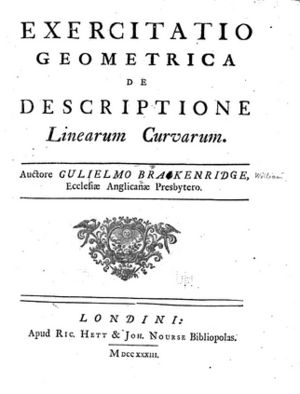William Braikenridge facts for kids
William Braikenridge (around 1700–1762) was a clever Scottish mathematician and a church leader. He was also a member of the important scientific group called the Royal Society starting in 1752.
His Life Story
William Braikenridge was the son of John Braikenridge from Glasgow. In the 1720s, he taught mathematics in Edinburgh.
Later, he earned special degrees from Marischal College in 1735 and 1739. At that time, he was a church leader, known as a vicar, in New Church on the Isle of Wight. In 1741, he joined The Queen's College, Oxford. He then became the rector (another type of church leader) of St Michael Bassishaw in London. From 1745, he also worked as a librarian at Sion College in London.
His Important Works
In the world of geometry, William Braikenridge is known for the Braikenridge–Maclaurin theorem. This was a cool idea about shapes and lines. Another smart mathematician, Colin Maclaurin, discovered the same idea around the same time. Braikenridge published his findings in 1733.
Here are some of the things William Braikenridge wrote:
- Exercitatio Geometrica de Descriptione Linearum Curvarum (1733): This book was about how to draw curved lines in geometry.
- Proposals for lectures on the principles of mechanicks and natural philosophy, by Mr. Braikenridge: Formerly teacher of the mathematicks at Edinburgh (around 1750): This was a plan for lessons on how things move and how nature works.
- A Letter from the Reverend William Brakenridge, D.D. and F.R.S. to George Lewis Scot, Esq; F. R. S. concerning the Number of Inhabitants within the London Bills of Mortality (1753): In this paper, published in the Philosophical Transactions, Braikenridge looked at old records called "bills of mortality." These records showed how many people were born and died in London. He thought London's population had stopped growing. This was a big topic because the government was thinking about counting everyone in the country.
- A letter to the right honourable the earl of Macclesfield, president of the Royal society, concerning the method of constructing a table for the probabilities of life at London (1755): This letter was about how to figure out how long people in London were likely to live.
- A Letter to the Right Honourable Hugh Earl of Marchmont. F. R. S. concerning the Sections of a Solid, Hitherto Not Considered by Geometers (1759): This paper discussed new ways to cut and understand solid shapes.
- Sermons on Several Subjects by the Late William Brakenridge: This was a collection of his speeches from church.


